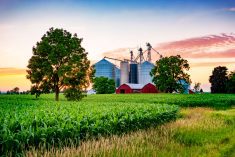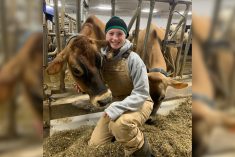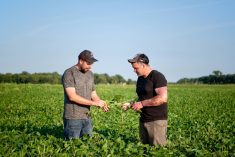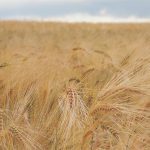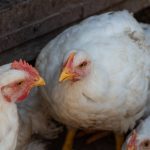Be prepared to see noticeably less corn in Canada’s cornbelt next year as farmers in southern Ontario and Quebec continue to switch acres to soybeans.
The 2011 federal Census of Agriculture documented a 33 per cent jump since 2006 in the number of acres farmers are planting to soybeans, and it isn’t at all hard to find anecdotal evidence that this trend will only continue into 2014.
Seed sales reps in Eastern Canada started seeing corn bookings drop significantly early in the fall, and the chill spread at meetings and through social media.
Read Also

Are you ready for farm succession?
What motivates some farmers to make a succession plan while others don’t seem worried.
While the trend may have levelled off later in the seed sales season, dealers like Elliot Lowry of Parrish & Heimbecker in Kincardine, Ont., say it won’t be uncommon to see growers skip corn altogether.
In fact, Lowry may be among them. Lowry runs a cash crop farm inland from Lake Huron at Ripley, Ont., where he grew 310 acres of corn this year. For 2014, he says, he won’t plant any corn at all. Instead, he’ll crop 100 acres of wheat, 200 acres of Identity Preserved (IP) soybeans, and 100 acres of white beans. “There’s a nice little spread between corn profits versus bean profits,” he explains.
Lowry lays out the numbers to prove it. He begins by referencing the Ontario Ministry of Agriculture and Food’s (OMAF) Publication 60 for corn’s cost of production, since he’s always found its numbers comparable to his own end-of-year figures. It lists total expenses for the 2800 CHU conventional corn he would plant on his farm at $538.55 per acre, and then he would add $200 per acre for land rent in his area. His yields ranged between 165 and 205 bushels per acre depending on the field, so at an average of 180 and considering the prices he could expect next fall, a farmer in his area is looking at a mere $756 in revenue and a bleak $17.45 per acre margin.
By contrast, conventional soybeans cost $289.85 before land rent, and with offers of $14 per bushel for IP beans, the average 45-bushel-per-acre bean crop would bring in $630 in revenue and a tidy $140.15-per-acre profit. Plus, he adds, you can get wheat in nice and early when you’re done.
“It always depends on how you can manage your equipment time too,” Lowry says. “If you don’t have to spread out your workload for planting and harvesting, that’s going to decide a lot of corn acres at this point.”
Lowry says that if he sees his wheat die off over the winter, that’s when he’ll change his plans for next year to include corn. But for now, soybeans are his darling.
On the Quebec border, soybeans have also come out the clear winner at the elevators this year. Arnold Kuratli operates St. Isidore’s grain storage operation, milking 100 head of dairy cattle, and cropping 3,000 acres of land. After growing 100 acres of corn silage, 1,100 acres of grain corn, 1,400 acres of soybeans, 250 acres of wheat, and using the rest of his land for hay this year, he’s committing to beans in a much bigger way for 2014. He’ll only plant 800 acres of corn, boosting his IP soybeans to 1,600.
“I think we’re already at break-even right now with the price of corn and $200-per-acre land costs,” says Kuratli. “The best opportunity to get better corn prices is if everybody lowered their acreage by 25 per cent.”
The switch has already helped him cut back his fertilizer, seed and chemicals costs by $100,000 compared to what he’d paid out by this time last year, and he’s locked in a healthy premium.
“If we have about a dozen countries looking for IP beans, I think we should produce them and take the pressure away from corn,” Kuratli says. “Producing less for a year or two is the best way to get the markets back to normal, and I’ll start with myself to do that, rather than tell someone else what to do or wait on the neighbours.”
Just south of Ottawa in North Gower, Ont., with very similar circumstances, Dwight Foster’s thinking couldn’t contrast more starkly. Foster also runs an elevator, a 2,500-head feedlot, and a 4,000-acre cash crop farm. Foster says there’s no doubt it was a win to grow soybeans over corn this year, but he wouldn’t tell someone not to grow corn next year. He trusts the markets will balance out again and he will probably wait until spring to make his final decision about any swing acres.
“Because we have the feedlot, we need to have a certain amount of corn,” Foster says. “The way our rotation works, you can’t just stack your soybean acres because the price is a little more favourable than on the corn side.”
Next year, Foster estimates he’ll plant 2,000 acres of soybeans and 2,200 acres of corn in the 2700-2800 heat unit range. Normally, his rotation includes spring wheat, which is more popular than winter wheat since local winters make “your odds better at Vegas,” but he’s thankful he didn’t get any in this spring. The number of acres they work means there isn’t time to do much tillage in the fall, which pretty much commits him to putting soybeans back on corn ground as far as he’s concerned.
“If I want to go corn on corn, I’ve got to pull my disc ripper out and that’s going to cost me $20 to $30 per acre just to get that ground ready to go back into corn, and then you’ve got to do your spring tillage,” says Foster. “We feel there are benefits to rotating even if maybe the price doesn’t always seem favourable.”
In Southwestern Ontario, winter wheat is much more of a factor. It’s a factor in the 2900-3100 CHU area that Daryl Haanstra of West Lincoln, Ont., services west of Niagara Falls too. Wheat is absolutely critical on his farm since he’s no tilling into heavy clay. Economics are pushing commitments on corn down and soybean sales up, but a poor planting season for winter wheat means there’s generally more acreage for both next spring. “We’re increasing our bean acres and cutting back on corn acres on our farm, but we did get 250 acres of wheat in because we grew a lot of short day beans,” Haanstra says. “The majority of the farmers around here didn’t get the wheat acres in that they had hoped to because it was too wet this fall.”
Jeff Shea of Shea Ag Ltd. believes his corn sales have remained mostly static largely because the wheat acreage was down. On his own family’s farm east of Sarnia, they only got 100 acres of wheat in, so the remaining acres will be split evenly between corn and beans.
“We’ll put more beans in and instead of growing all 3000 CHU beans, we’ll probably have some 2900 CHU beans on two or three farms to get started a little earlier and get the wheat in that we missed out on this fall,” says Shea. But they won’t be IP beans, which Shea says they have grown in the past but aren’t really set up to store.
Weed resistance comes into the equation too, Shea adds.
“Canada fleabane resistance wasn’t a huge problem this year, but you can see that, if we don’t get a solution soon, it’s probably going to become a really big problem,” Shea explains. “If I have a bunch of Canada fleabane that got away on me in a Roundup Ready field, they’re not going to dock me my IP premium.”
Jason Chyc, not far from Lake Erie’s north shore near St. Thomas, Ont., shares the same concerns about resistant fleabane in his area, but the premium’s worth it to him to walk his fields in the summer more so he can stay on top of any problems.
That’s not something he could have done when they used to be making hay for a herd of dairy cattle but it’s a perfect example of how there’s no right or wrong way of doing things on your farm when you have a process that works for you. Rotation is a priority on their 1,000-acre farm but instead of mudding in wheat this fall, he’s planning a 50/50 split of corn and beans next year. At the end of the day, he respects every farmer’s strategy and always looks to learn from other people’s decision-making process.
“We have a program, that’s what we do every year, and that seems to be paying off for us,” Chyc says. “I truly believe a good farmer has a process and they follow that process every year.”




